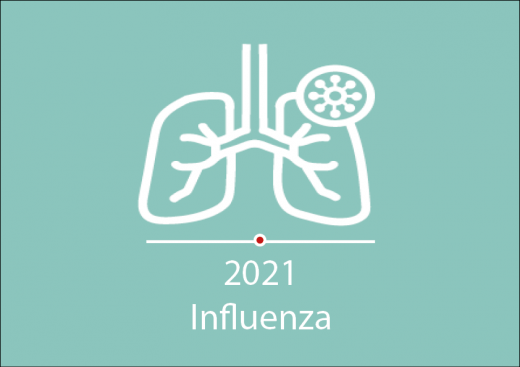12/12/2020
Influenza - the theme of SensUs 2021
Pandemics: Corona and influenza
The corona virus pandemic of 2020 caught the world off guard. Millions of people worldwide have got infected by this virus and it has a significant impact on society. However, this is not the first respiratory pandemic the world has seen. The influenza virus has caused four major pandemics over the last 100 years. Starting with the H1N1 Spanish flu in 1918, which resulted in approximately 40-50 million deaths. After that, the H2N2 Asian flu caused around 2 million deaths in 1957 and the H3N2 Hong Kong flu was the reason for at least 500 thousand deaths between 1968 and 1970. The most recent influenza pandemic was in 2009, where the H1N1 swine flu caused up to 575 thousand deaths. [1]
Even though there has not been an influenza pandemic since 2009, local epidemics of influenza cause 290,000 to 650,000 deaths each year according to the WHO [2].
What is influenza?
Influenza, commonly known as the flu, is a respiratory viral infection that affects the lungs. Symptoms include coughing, sneezing, sore throat, fever, headaches, and fatigue [3]. The virus arrives in the human body via the air that we breathe [4] and attaches to the receptors of the upper cells of the airway. The cells are infected and start to produce a lot of viral particles, which causes damage to the cells. Our immune system reacts to the virus, destroys the infected cells and after 5-9 days the virus is normally eliminated from the body. [5]

How does one get influenza?
Transmission of influenza happens through the air from person to person when they are within a short distance or through direct contact, like giving a hand or kissing [6, 7]. The infected person spreads the influenza virus by coughing or sneezing the virus-containing droplets into the air, after which the droplets can be breathed in by another person, who is then infected too [8].
How is influenza treated?
Getting influenza is not dangerous for healthy people. A healthy person does not need intensive treatment; resting and a healthy diet will do the work. Being infected with influenza is dangerous for patients in risk groups, for example, the elderly and chronically diseased. They can have severe symptoms of influenza and may need antiviral medication or hospitalization.
To protect the risk groups, prevention of an influenza outbreak is very important. In many countries, high-risk groups have the possibility to get a flu shot, which is a vaccine for certain types of influenza predicted to circulate that flu season. Next to the vaccination, general public hygiene prevents the spread of influenza. [3]
How can SensUs innovate rapid influenza testing?
Influenza is very prone to mutations. This means that each year, different strains pop up and even small mutations could have a big impact on the infectiousness and deadliness of the virus. Therefore a pandemic-causing strain of influenza could appear very quickly. [4] In case of a pandemic, being able to rapidly test the population is crucial for preventing the spread of the virus.
SensUs 2021 strives to innovate the rapid testing methods for influenza by encouraging international students to make a biosensing device for influenza A, the most common type of influenza. Measurements will be done in saliva, because saliva would make the testing easy and very accessible. Since the virus spreads through the air, the presence of viral particles in saliva indicates that a patient is infected and that the patient is actively spreading the virus. The tested patient can directly go into isolation, stopping the spread of influenza. Therefore, innovations done at SensUs 2021 may lead to new sensors that help to prepare for the next influenza pandemic!
Literature
[1] Saunders-Hastings, P. R., & Krewski, D. (2016). Reviewing the History of Pandemic Influenza: Understanding Patterns of Emergence and Transmission. Pathogens (Basel, Switzerland), 5(4), 66. https://doi.org/10.3390/pathogens5040066
[2] Influenza (Seasonal). (2018, 6 november). https://www.who.int/news-room/fact-sheets/detail/influenza-(seasonal)
[3]Meijer, A. (2012, februari). Influenza richtlijn. LCI richtlijnen. https://lci.rivm.nl/richtlijnen/influenza
[4] Kuiken, T., & Taubenberger, J. K. (2008). Pathology of human influenza revisited. Vaccine, 26 Suppl 4(Suppl 4), D59–D66. https://doi.org/10.1016/j.vaccine.2008.07.025
[5] Baccam, P., Beauchemin, C., Macken, C. A., Hayden, F. G., & Perelson, A. S. (2006). Kinetics of Influenza A Virus Infection in Humans. Journal of Virology, 80(15), 7590–7599. https://doi.org/10.1128/jvi.01623-05
[6] Tellier R. (2006). Review of aerosol transmission of influenza A virus. Emerging infectious diseases, 12(11), 1657–1662. https://doi.org/10.3201/eid1211.060426
[7] Tellier R. (2009). Aerosol transmission of influenza A virus: a review of new studies. Journal of the Royal Society, Interface, 6 Suppl 6(Suppl 6), S783–S790. https://doi.org/10.1098/rsif.2009.0302.focus
[8]Chen, S. C., Chio, C. P., Jou, L. J., & Liao, C. M. (2009). Viral kinetics and exhaled droplet size affect indoor transmission dynamics of influenza infection. Indoor air, 19(5), 401–413. https://doi.org/10.1111/j.1600-0668.2009.00603.x

Facebook
YouTube
LinkedIn
Instagram